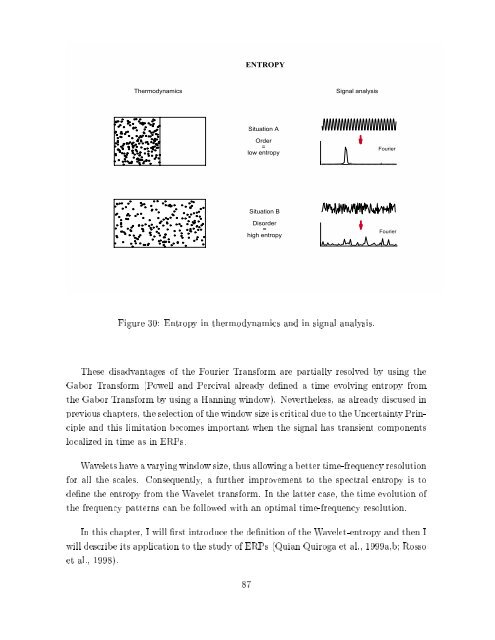Quantitative analysis of EEG signals: Time-frequency methods and ...
Quantitative analysis of EEG signals: Time-frequency methods and ...
Quantitative analysis of EEG signals: Time-frequency methods and ...
You also want an ePaper? Increase the reach of your titles
YUMPU automatically turns print PDFs into web optimized ePapers that Google loves.
ENTROPY<br />
Thermodynamics<br />
Signal <strong>analysis</strong><br />
Situation A<br />
Order<br />
=<br />
low entropy<br />
Fourier<br />
Situation B<br />
Disorder<br />
=<br />
high entropy<br />
Fourier<br />
Figure 30: Entropy in thermodynamics <strong>and</strong> in signal <strong>analysis</strong>.<br />
These disadvantages <strong>of</strong> the Fourier Transform are partially resolved by using the<br />
Gabor Transform (Powell <strong>and</strong> Percival already dened a time evolving entropy from<br />
the Gabor Transform by using a Hanning window). Nevertheless, as already discused in<br />
previous chapters, the selection <strong>of</strong> the window size is critical due to the UncertaintyPrinciple<br />
<strong>and</strong> this limitation becomes important when the signal has transient components<br />
localized in time as in ERPs.<br />
Wavelets haveavarying window size, thus allowing a better time-<strong>frequency</strong> resolution<br />
for all the scales. Consequently, a further improvement to the spectral entropy is to<br />
dene the entropy from the Wavelet transform. In the latter case, the time evolution <strong>of</strong><br />
the <strong>frequency</strong> patterns can be followed with an optimal time-<strong>frequency</strong> resolution.<br />
In this chapter, I will rst introduce the denition <strong>of</strong> the Wavelet-entropy <strong>and</strong> then I<br />
will describe its application to the study <strong>of</strong> ERPs (Quian Quiroga et al., 1999a,b Rosso<br />
et al., 1998).<br />
87




